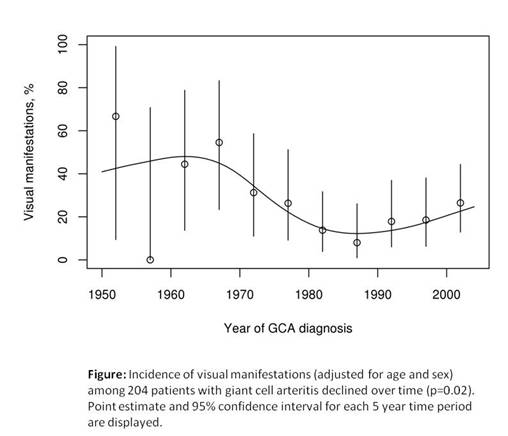Background/Purpose: Cranial ischemic complications, particularly permanent visual loss, are catastrophic complications of giant cell arteritis (GCA). Corticosteroids have been used to decrease the risk of vision loss but it is unclear if the rate of visual complications has changed in recent decades. We examined trends in visual manifestations in GCA over the last 5 decades.
Methods: We reviewed the medical records of a population-based cohort of patients with GCA meeting ACR classification criteria, diagnosed between 1950 and 2004. We characterized the clinical, ophthalmological and laboratory features of patients with visual manifestations and compared them with patients who did not develop visual complications. Trends of visual manifestations in GCA over time were examined using logistic regression model adjusted for age and sex.
Results: 204 cases of GCA were identified (mean age 76.0 ± 8.2 years, 80% female) of which 47 had visual manifestations attributable to GCA at presentation. Blurred vision (15%) and diplopia (5%) were the most common visual symptoms. Ischemic optic neuropathy (ION) was the predominant ophthalmologic diagnosis (17/204, 8%). Nine patients (4.4%) suffered complete loss of vision. As compared to patients with GCA without visual manifestations at presentation, patients with visual manifestations were more likely to have associated jaw claudication (59/157 v.s 26/47, p =0.04), but were similar with regard to other clinical (age, smoking status, headache, scalp tenderness, constitutional symptoms, frequency of polymyalgia rheumatica) and laboratory features.
Recovery from visual symptoms was less likely in patients with complete vision loss as compared to those with blurred vision alone [Hazard ratio, 95% Confidence Interval (HR, 95% CI): 0.20 (0.06-0.63), p<0.01], and in patients with ION or central retinal artery occlusion as compared to other diagnoses [HR (95% CI): 0.22(0.10-0.49), p<0.001].
Over a period of 55 years, there has been a significant decline in the incidence of visual symptoms (figure) and ION [1950-1979 vs 1980-2004: 9/61 (15%) vs 8/143 (6%), p=0.03] with time. Additionally, patients diagnosed more recently were more likely to have recovery from visual symptoms than patients diagnosed in earlier years [HR (95% CI): 1.34 (1.06-1.71) per 10 year increase in calendar year, p=0.016].
Conclusion: In this population-based cohort study of patients with GCA we found that the incidence of visual symptoms and ION has declined over the past 5 decades, and chances of recovery from visual symptoms have improved. Reasons for this improvement are unclear but may relate to increased disease awareness, earlier diagnosis and timely initiation of treatment.
Disclosure:
A. G. Singh,
None;
C. S. Crowson,
None;
T. A. Kermani,
None;
C. M. Weyand,
None;
E. L. Matteson,
Centocor, Inc./Johnson and Johnson,
2,
Genentech and Biogen IDEC Inc.,
2,
Hoffmann-La Roche, Inc.,
2,
Human Genome Sciences, Inc.,
2,
Pfizer Inc,
2,
Novartis Pharmaceutical Corporation,
2,
Roche Pharmaceuticals,
2,
UCB Group,
2,
Centocor, Inc.,
5,
Horizon Pharma,
5,
Novartis Pharmaceutical Corporation,
5;
K. J. Warrington,
None.
« Back to 2012 ACR/ARHP Annual Meeting
ACR Meeting Abstracts - https://acrabstracts.org/abstract/visual-manifestations-in-giant-cell-arteritis-trend-over-five-decades/

